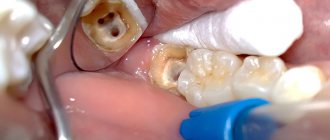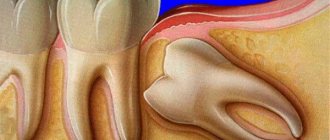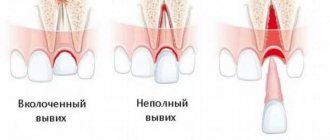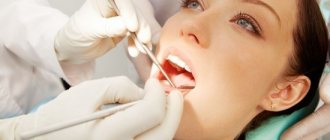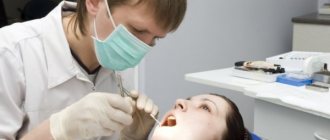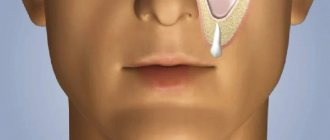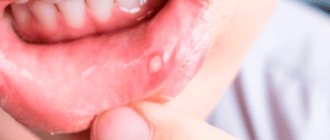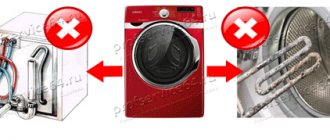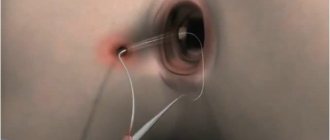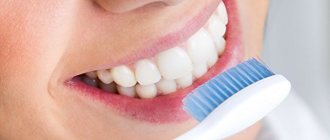How to restore a damaged tooth?
Yes, you can.
But everything will depend on the volume of the lost coronal part and the general condition of the oral cavity. For restoration, modern dentists use the following two main methods:
- installation of pins (reinforcement) made of fiberglass or titanium;
- introduction of so-called stump inlays.
If more than 50% of the unit is destroyed, and the dentist has doubts that the crown restored with a stump or pin will not withstand the chewing load, a metal-ceramic crown is installed on the stump pin inlay. When restoring teeth, it is mandatory to clean and fill the canals to avoid the development of caries.
Treatment of a damaged tooth involves the following steps:
- examination by a dentist and assessment of further “future” damaged teeth;
- restoration of the stump area using a pin or inlay. The dentist treats the canals, strengthens the unit from the inside, thereby providing reliable support for the filling;
- The crown is built up using a composite material. If the work is done efficiently, the tooth can be visually almost indistinguishable from a natural one. The dentist repeats the shape, color and even transparency.
Disadvantages and advantages of tooth extraction
The patient himself always decides whether or not to remove a tooth. Only in acute situations that threaten human health does a doctor make a decision. What are the disadvantages and advantages of removing a diseased tooth? Disadvantages include an unaesthetic appearance, speech impairment and difficulty chewing food. And the significant benefits, of course, are the disappearance of acute pain, which will never bother you again.
When contacting a dentist, the patient must immediately notify the doctor about any allergic reactions to medications and the consequences of previously extracted teeth, as well as, without fail, about chronic diseases.
When can a tooth be treated?
Disputes in dentistry usually center on third molars. Some experts do not see their value, considering them an additional source of infection. However, this is a misconception. Removal of figure eights is mandatory if they are located incorrectly in the bone and the hood of the mucous membrane that forms over them is constantly inflamed. This condition is called chronic pericoronitis.
In other situations, dentists try to cure them, because with a large loss of molars, this dental unit can function as a support for bridges or removable dentures.
We suggest you familiarize yourself with: Apparatus for cleaning teeth with water
For other dental units, the situation is simpler. Teeth affected by:
- Carious process.
- Periodontitis is inflammation of the tissue surrounding the root.
- Pulpitis is inflammation of the neurovascular bundle.
The carious process is treated by filling the cavity using modern filling materials. Pulpitis and periodontitis are treated endodontically. To do this, the inflamed pulp is removed from the coronal part of the tooth and canals, and then the resulting voids are filled with endodontic filling material.
Treatment for periodontal disease is also possible if the degree of pathological mobility is small. With this diagnosis, treatment is most often carried out by splinting.
Harmful tips for self-removal of teeth
As they write on the Internet, first you need to make sure that your future victim is a bad tooth. After all, very often painful sensations appear in adjacent tissues. A diseased tooth is revealed by reddened gums or the color of the enamel itself. In this case, there is no room for error, because otherwise you will have to fork out for an expensive implant.
Then we brush our teeth and treat the oral cavity with an antiseptic. No, this is not vodka. This is an antiseptic solution that can be purchased at any pharmacy. You can also use it to treat all nearby surfaces and hands, but it is unlikely to save you from the danger of contracting an infection.
Now anesthesia, if you can call the procedure of taking painkillers at home. Let us immediately note that you cannot obtain strong anesthesia without a doctor’s prescription, so you will have to be content with “head pills,” as people say. Medicines take 20 to 30 minutes to start working, so you have time to change your mind.
The culmination is removal. On the Internet, it is advised to wrap the tooth in a sterile bandage and napkin, then grab it tightly with your fingers and begin to loosen it in different directions. In this case, you must try to pull it out of the gums. Once the treasured tooth is in your hands, you urgently need to stop the bleeding. To do this, you will need several sterile swabs soaked in an antiseptic solution.
As soon as the bleeding stops, you need to rinse your mouth with an antiseptic and inspect the hole for the presence of tooth root remains, fragments of bandage or cotton wool. If they are there, then you can take the risk and reach into the already huge wound with tweezers.
A cold compress will help relieve swelling. We also advise you to refrain from eating for about four hours, and it is better to completely avoid alcohol and cigarettes until the gums have completely healed. If the pain does not go away after removal, you can take the painkiller again.
After studying all this information, we decided that such an operation is extremely unsafe and traumatic. In addition, a person without special education is unlikely to be able to choose the right instrument for removal, will not choose effective painkillers, and will not stop the bleeding.
Light filling on a pin – what are the advantages of the method?
A post filling is considered a reliable replacement material when a dentist is restoring a fractured unit. A titanium or fiberglass pin is inserted into the root canal, after which the coronal part is restored with a composite material. Among the disadvantages of the method is the potential risk of root fracture, since the pin fails under pressure, as well as shrinkage of the filling and the development of secondary caries under it.
Unfortunately, teeth restored in this way do not last forever. After 3–5 years, the dentist will have to change the filling or, due to global destruction of the crown, perform prosthetics/implantation.
What to do after tooth extraction: general recommendations
If bleeding from the hole begins.
Typically, bleeding should stop after tooth extraction in about half an hour. Earlier in this article, we mentioned that the doctor places a sterile cotton swab on the hole, and the patient needs to press it tightly for an hour. But in some cases, bleeding continues for several hours longer. In this case, you may need a sterile bandage - you need to cut off a small piece with thoroughly washed hands, form a tampon from it and repeat the procedure. But, if bleeding continues for more than two to three hours, you should urgently seek medical help from a doctor.
Formation of a blood clot in the socket.
Experts assure that such a clot after the tooth extraction procedure is actually necessary for further successful healing of the wound. Therefore, there is no need to worry. It is important to follow the following list of rules in order to prevent the destruction and removal of a blood clot:
- Smoking and drinking drinks through a straw often leads to some displacement of the blood clot. This is explained by the fact that during smoking and drinking a vacuum is formed in the mouth, which, in turn, causes the clot to dislodge;
- do not rinse your mouth and try not to spit saliva in the first day after tooth extraction;
- do not drink hot liquids (tea, coffee) and do not eat hot food (for example, soups/borscht) - this may lead to the dissolution of the formed blood clot;
If swelling appears.
If your cheek is swollen after tooth extraction, this is normal, as this happens sometimes. It is believed that the more difficult the extraction procedure, the higher the likelihood that swelling of the soft tissues adjacent to the extracted tooth will occur. In order to remove such a tumor, doctors usually advise patients to apply the lek to the cheek for about ten minutes (this should be done every hour). This procedure should be continued until the swelling disappears. Just do not under any circumstances apply ice to the gum itself - this can lead to infectious inflammation, as pathogenic microorganisms may enter the wound.
In what cases is tooth extraction indicated?
Removal is carried out in the following clinical situations:
- Periodontitis in the acute stage of its course (especially if the root canals are impassable).
- Trauma leading to transverse fracture of the crown and root of the tooth.
- Osteomyelitis of the jaw bone, if the dental unit is in the projection of the pathological focus. The tooth is removed in order to improve the outflow of purulent exudate.
- A jaw fracture when the dental unit is localized in the fracture line.
- Caries, accompanied by significant destruction of dental tissue.
- A tooth that is located incorrectly and injures the soft tissues of the oral cavity. In this situation, it is removed only if it is not possible to correct the situation using the orthodontic method.
- The destruction of dental tissue is below the gum level and there is no way to build it up with a dental inlay.
- Pulpitis and periodontitis of primary teeth in the chronic stage.
We invite you to read: Tooth treatment under a metal-ceramic crown
Sometimes a situation arises when the dentist begins endodontic treatment, during which the instrument breaks off and the tooth wall or bottom is perforated. If the instrument cannot be removed and the perforation cannot be closed using delayed filling with calcium-containing preparations, such teeth are also removed. Read more about tooth extraction →
Under no circumstances should you decide the fate of a tooth on your own. If at the first sign of pain you run to the doctor for removal, you can be diagnosed with complete secondary adentia at a young age. Prosthetics in such a situation will be carried out only with removable dentures, which is not very practical.
In addition, each tooth loss will be accompanied by an increased chewing load on other units. They will begin to mix and tilt in different directions, leading to bite pathology and problems with the temporomandibular joint. The end result of this vicious circle will be gastrointestinal diseases.
You need to make an appointment with the dentist as soon as you notice the first signs of damage to the dental tissues. There is no need to wait until your tooth hurts. Remember, any disease can be prevented. To do this, practice oral hygiene and visit the dentist periodically.
If he bothers others
There are a number of indications that are not associated with disease. Sometimes it needs to be removed in order to carry out certain procedures or treatments, for example:
- must be removed located at the site of a fracture of the jaw or alveolar process, as it may interfere with the removal of fragments that can become a source of infection
- if it injures the oral mucosa due to its atypical location and for some reason is not subject to orthodontic treatment.
- teeth are also removed when it is necessary to make room for the eruption of others.
- if, due to improper location, the entire dentition shifts, which disrupts chewing functions and distorts facial features.
- in the presence of a strong inflammatory process around the erupting teeth (wisdom teeth).
Photo: Case when they need to be removed
If it interferes with prosthetics:
These include single ones that prevent reliable fixation of the prosthesis or are pushed out in the absence of antagonist teeth. Roots that are strongly protruded from the socket with exposed roots may also be subject to removal, which can interfere not only with prosthetics, but also with generally normal chewing and injure soft tissues.
